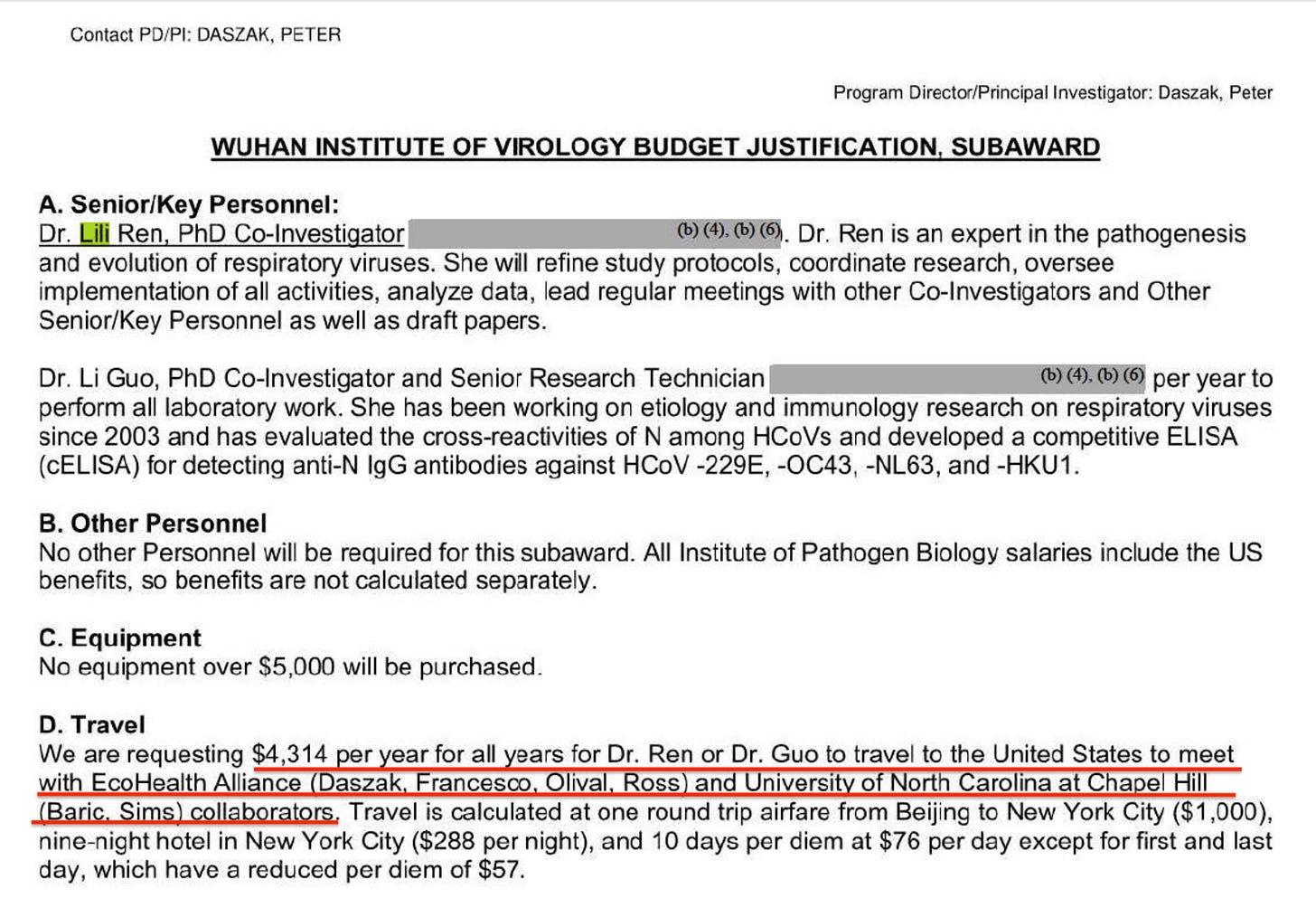DOCUMENTS: Chinese Researcher Who Mapped COVID Virus Two Weeks Before China Released Sequence Was on Anthony Fauci’s Payroll
NIH officials refuse to explain how much salary they provided to Chinese researcher Lili Ren, a co-investigator with Peter Daszak of EcoHealth Alliance.
4 minute read
A Chinese researcher who first submitted the genetic sequence for the SARS-CoV-2 virus in late December 2019, around two weeks before China disclosed the deadly virus to outside scientists, was on the payroll of Anthony Fauci’s institute at the time, according to a grant awarded to EcoHealth Alliance, a nonprofit operated by Peter Daszak. The disclosures call into further question what officials at the National Institutes of Health (NIH) knew about research they were funding in China where the pandemic began.
“The grant doesn't work on SARS-CoV-2,” Daszak told Nature Magazine, when the NIH was forced to review the grant in the summer of 2020. “Our organization has not actually published any data on SARS-CoV-2. We work on bat coronaviruses that are out there in the wild and trying to predict what the next one is. We don't work on sequencing SARS-CoV-2.”
Speaking to the Wall Street Journal, which first broke the story, several experts said the extra two weeks could have helped researchers better understand how COVID spread and develop therapies.
NIH officials refused to respond to multiple requests to explain how much salary they provided to Dr. Lili Ren, a scientist at the Beijing-based Institute of Pathogen Biology, who wrote a letter in support of Daszak’s grant application to Fauci’s NIH institute. Documents from the U.S. Department of Health and Human Services released by a congressional committee show that Ren first uploaded the COVID virus sequence to the NIH’s GenBank on December 28, 2019—two weeks before scientists celebrated China’s release of the genetic sequence on January 11, 2020.
“The Department of Health and Human Services (HHS) has confirmed that Dr. Ren’s December 28, 2019, sequence was nearly identical to the sequence later made public by the China CDC on January 10, 2020, which at the time was the first known sequence,” said members of the House Energy & Commerce committee in a statement.
Anthony Fauci’s NIH institute awarded the grant in 2015 to Peter Daszak’s EcoHealth Alliance, who partnered with Ren as a co-investigator on a multi-year project titled “Understanding the Risk of Bat Coronavirus Emergence.” The grant shows that taxpayers paid Ren a salary, although NIH redacted the amounts for salary and benefits.
Fauci’s NIH grant also paid for Ren’s expenses, including travel to the United States to meet with Daszak as well as her collaborator Ralph Baric at the University of North Carolina.
As previously reported by The DisInformation Chronicle, Baric helped to ghostwrite a commentary titled, “No credible evidence supporting claims of the laboratory engineering of SARS-CoV-2“ that appeared in the journal Emerging Microbes & Infections. Published early in the pandemic, the commentary dismissed the possibility of a lab accident in China as a “conspiracy theory.”
“Sure, but don’t want to be cited in as having commented prior to submission,” Baric emailed the commentary’s listed authors, when asked to comment. After submitting several alterations to the text in track changes, Baric added, “I think the community needs to write these editorials and I thank you for your efforts.” Baric’s name does not appear as an author on the published commentary.
An HHS official wrote in a letter last month to the House committee that the sequence Ren sent to GenBank in December 2019 was never published. NIH later deleted it from the database, after Ren did not respond to NIH requests to provide more technical details.
The NIH then published a COVID sequence from another source on January, 12, 2020.
“The sequence published on Jan. 12, 2020, was nearly identical to the sequence that was submitted by Lili Ren,” HHS wrote to the House committee.









Th trouble with online is it can disappear. Hopefully people have hard copies. So much that goes on is back scratching. You scratch my back and I’ll scratch yours. Wading through so many documents, emails etc. trying to connect the dots must be like finding your way through a complicated labyrinth.
So Ren blows it by submitting sequence data that doesn't match up with the proposed Wet Market origin theory? If those sequences are from very early swabs not only from Wuhan but Guangdong they are going to have to explain why those sequences don't resemble the later, submitted, genome that purports RatG13 lineage.
There are just a few people able to interpret this early on, someone has to be coordinating any data sets that don't align with the Wet Market scenario before the CCP has a chance to take out the 241 sequence reads that happens post March 30. Bloom can only recover 13 of the 241 reads from the clouds that he's able to retrieve and those reads don't correlate with the Wet Market strain.
So my take is NIH is covering it's tracks early on but they have to wait until the CCP can get a handle on destroying or eliminating early sequence reads and tissue swab samples, at which point NIH just stonewalls it because the data is gone anyway.
There really isn't a plausible explanation of the disappearance of the early sequence reads unless you're locked into the Wet Market scenario.
Maybe I've got it wrong but I don't think it's that far wrong.......